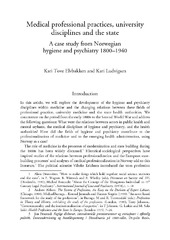Medical professional practices, university disciplines and the state: A case study from Norwegian hygiene and psychiatry 1800-1940
Peer reviewed, Journal article
Published version

Åpne
Permanent lenke
https://hdl.handle.net/1956/15300Utgivelsesdato
2016-05-16Metadata
Vis full innførselSamlinger
- Department of Government [457]
Originalversjon
https://doi.org/10.3384/hygiea.1403-8668.161227Sammendrag
A number of studies have emphasized the close relations between the medical profession and the health authorities, both internationally and in Norway specifically. As the medical profession tends to be analysed as a homogeneous unit, the processes of professional development and the varying roles and relations between different segments within the profession are not often considered. We aim to contribute to the understanding of the changing relations between the medical profession and the state, having conducted a case study of the disciplines and practices of hygiene and psychiatry in Norway. We scrutinize the development of two medical segments; hygiene and psychiatry, and trace the changing relations between these fields of practice, university medicine and the health authorities, focusing the period from 1800 to the Second World War. The data sources include reports from the university, the government and research literature on the two fields of practice and science. We address the relations between actors in public health and mental asylums, the university disciplines of hygiene and psychiatry, and the health authorities. Further, we discuss how these segments contributed to the professionalization of medicine and to the health administration, and argue that these fields of medicine provided important foundation for medical authority.
